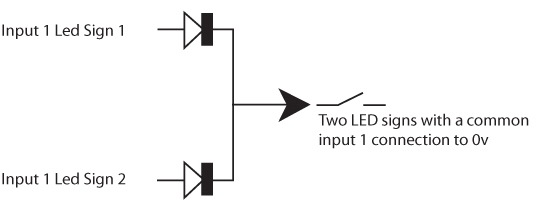FAQs
Sonifex SignalLED Frequently Asked Questions
 This FAQ (frequently asked questions) answers some of the popular questions asked about the SignalLED Studio Illuminated Sign and how it operates. If you have any specific questions regarding the operation of an SignalLED Studio Illuminated Sign which aren't covered below, please contact your nearest distributor, or Sonifex directly.
This FAQ (frequently asked questions) answers some of the popular questions asked about the SignalLED Studio Illuminated Sign and how it operates. If you have any specific questions regarding the operation of an SignalLED Studio Illuminated Sign which aren't covered below, please contact your nearest distributor, or Sonifex directly.
Related Links:
Download this FAQ as a PDF file >
SignalLED Home Page >
DC PSU Modification to Allow Use of 7V-36V DC Input >
Connecting the Redbox RB-OA3 to a LED Sign
In order to provide an on air indication from the RB-OA3 to an ON AIR LED sign the accept signal can be used. Unfortunately, this signal is referenced to 15v so direct interface is not possible. The two units can be used together however, by using an external relay to provide the switching of the relevant LED sign input.
The coil of the relay would then be connected between the 15v supply of the RB-OA3 control port and the accept ground. Then the normally open contact pins could be connected to the LED sign and would switch it on when that studio accepts.
Precautions to be taken when connecting multiple LED signs to the same inputs
Please note it is essential that the ground pin (pin 3) is connected properly before powering up the sign, or firmware corruption may occur. The signalling inputs are used to control the sign and are pulled low (to 0V, pin 3) to activate.
On signs manufactured before 14/10/2011. If driving more than one LED sign from the signalling inputs, or power supply, then the LED sign pins should be diode protected to prevent a reverse current condition.

What is the maximum cable length I can use for power on an LED sign?
That depends on the type of cable used and its impedance per metre.
For example on a CAT5 network cable, the cable typically has a loop impedance of 0.188 ohms per metre so if your LED sign was powered by a 7 volt supply from one cat 5 pair then the total possible cable length could be calculated by:
( maximum sustainable voltage drop / max current drawn) /resistance per metre
so for one Led sign that would be (2 / 0.4) / 0.188 = 26.6 metres
This length could be doubled or tripled by using parallel connections, so using two pairs would half the effective impedance and therefore double the total distance and using three pairs would make the total impedance a third of its original value and therefore the total cable length would be 3 times its original value.
Adding other LED signs would of course mean that more current was drawn and the 0.4A would need to be multiplied by the total number of signs.
The signalling wires are low current logic lines and therefore will likely only require one pair of wires.
